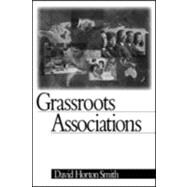
Note: Supplemental materials are not guaranteed with Rental or Used book purchases.
Purchase Benefits
What is included with this book?
| Key Abbreviations in This Book | ix | ||||
| Foreword | x | ||||
| Preface | xiii | ||||
| PART I: TOWARD A ROUND-EARTH PARADIGM FOR THE VOLUNTARY NONPROFIT SECTOR | |||||
|
3 | (1) | |||
|
4 | (3) | |||
|
7 | (26) | |||
|
7 | (3) | |||
|
10 | (2) | |||
|
12 | (1) | |||
|
13 | (2) | |||
|
15 | (13) | |||
|
28 | (5) | |||
|
33 | (38) | |||
|
36 | (9) | |||
|
45 | (8) | |||
|
53 | (2) | |||
|
55 | (5) | |||
|
60 | (7) | |||
| PART II: THE DISTINCTIVE NATURE OF GRASSROOTS ASSOCIATIONS | |||||
|
67 | (4) | |||
|
71 | (20) | |||
|
71 | (17) | |||
|
88 | (3) | |||
|
91 | (16) | |||
|
92 | (3) | |||
|
95 | (8) | |||
|
103 | (1) | |||
|
103 | (4) | |||
|
107 | (20) | |||
|
107 | (16) | |||
|
123 | (4) | |||
|
127 | (22) | |||
|
127 | (19) | |||
|
146 | (3) | |||
|
149 | (18) | |||
|
149 | (14) | |||
|
163 | (1) | |||
|
164 | (3) | |||
|
167 | (28) | |||
|
167 | (2) | |||
|
169 | (2) | |||
|
171 | (2) | |||
|
173 | (5) | |||
|
178 | (3) | |||
|
181 | (11) | |||
|
192 | (3) | |||
|
195 | (22) | |||
|
196 | (10) | |||
|
206 | (3) | |||
|
209 | (2) | |||
|
211 | (4) | |||
| PART III: THEORETICAL PARADIGMS AND CONCLUSIONS | |||||
|
215 | (2) | |||
|
217 | (26) | |||
|
217 | (2) | |||
|
219 | (19) | |||
|
238 | (2) | |||
|
240 | (1) | |||
|
241 | (2) | |||
|
243 | (20) | |||
|
243 | (1) | |||
|
244 | (1) | |||
|
245 | (1) | |||
|
246 | (2) | |||
|
248 | (2) | |||
|
250 | (1) | |||
|
250 | (1) | |||
|
251 | (1) | |||
|
252 | (2) | |||
|
254 | (5) | |||
|
259 | (4) | |||
| Appendix A: Description of the (Largely North American) Association for Research on Nonprofit Organizations and Voluntary Action | 263 | (4) | |||
| Appendix B: Creating a Local Nonprofit Sampling Frame Including Grassroots Associations: An American Example | 267 | (12) | |||
|
268 | (5) | |||
|
273 | (1) | |||
|
274 | (1) | |||
|
275 | (4) | |||
| Appendix C: Methodology of the Smith One-Suburb Study | 279 | (4) | |||
| References | 283 | (38) | |||
| Index | 321 | (21) | |||
| About the Author | 342 |
The New copy of this book will include any supplemental materials advertised. Please check the title of the book to determine if it should include any access cards, study guides, lab manuals, CDs, etc.
The Used, Rental and eBook copies of this book are not guaranteed to include any supplemental materials. Typically, only the book itself is included. This is true even if the title states it includes any access cards, study guides, lab manuals, CDs, etc.